Java基础干货LinkedList源码剖析
Posted 在路上的德尔菲
tags:
篇首语:本文由小常识网(cha138.com)小编为大家整理,主要介绍了Java基础干货LinkedList源码剖析相关的知识,希望对你有一定的参考价值。
微信公众号:Duffy说码
[如果你觉得这篇文章对你有帮助,欢迎关注]
本文所有代码来自JDK1.8
引子
想象幼儿园小朋友放学回家,老师要求小朋友们排成一字队,前后小朋友都手牵着手,举个栗子小明是排在前面第一位同学,他的右手牵着后面小红的左手,小红的右手牵着后面小强的左手,以此类推,直到所有大家都手牵着手,开开心心的放学回家~
由于小冯刚刚拉肚子没有在队伍中,他现在想加入到队伍中而且想站在小红的后面,他需要先让小红和小强的手松开,然后左手牵住小红的右手,右手牵住小强的左手,这样就加入到队伍中了。
其实这种结构就像LinkedList
简介
public class LinkedList<E>
extends AbstractSequentialList<E>
implements List<E>, Deque<E>, Cloneable, java.io.Serializable
LinkedList继承AbstractSequentialList类,实现了List, Deque(双端队列,具有队列和栈性质的一种数据结构), Cloneable, java.io.Serializable接口。
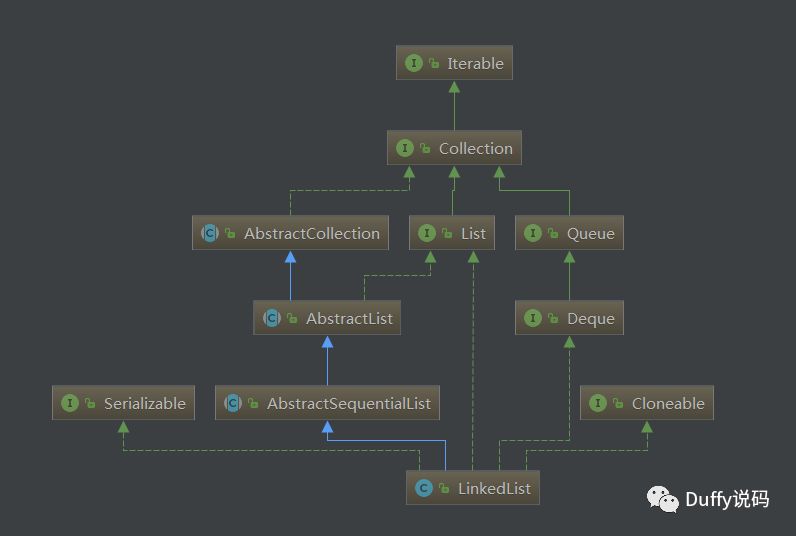
如果可以用简短的一段话概括:底层结构是Node构成的双向链表,每个Node具有前后两个指针,不要求存储空间连续;适合插入与删除,是有序的,不是线程安全的,允许null元素,允许链表为空,允许有重复元素。
基本功能演示,结果是你预期的吗?
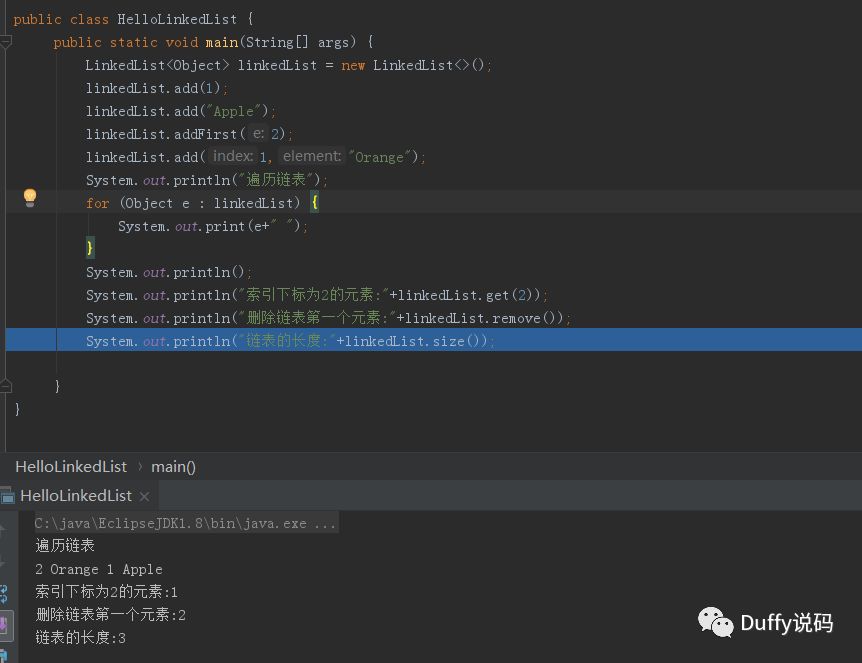
注意remove()方法,其实是删除链表指向first的元素,后面详细介绍
LinkedList实现的接口较多,因此方法较多

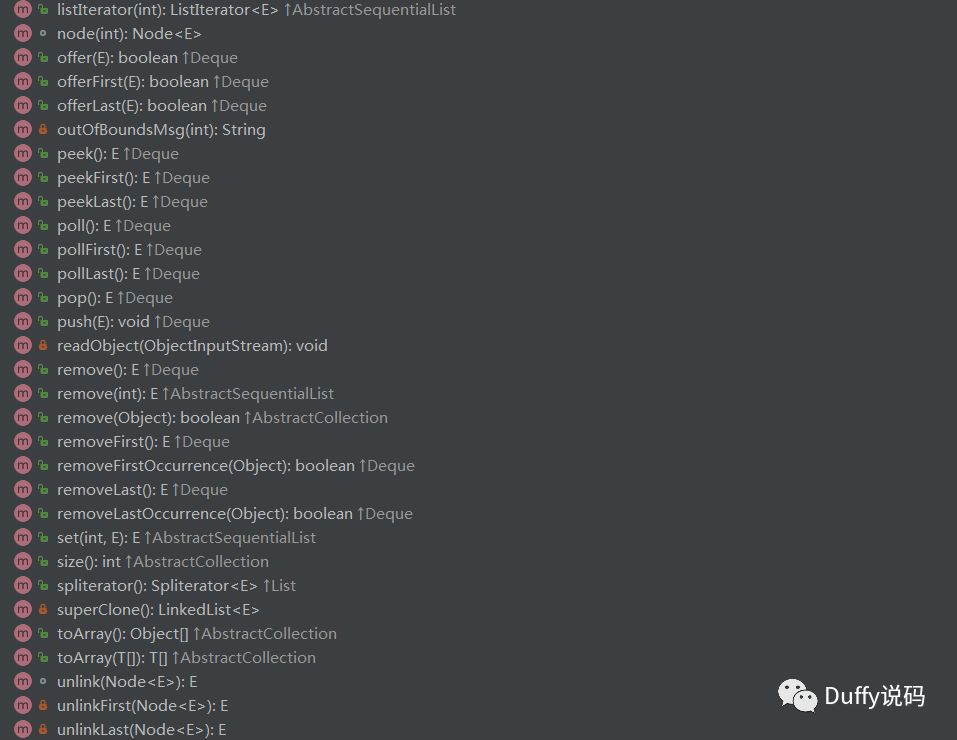
源码分析
成员属性及构造函数
transient int size = 0;
/**
* Pointer to first node.
* Invariant: (first == null && last == null) ||
* (first.prev == null && first.item != null)
*/
transient Node<E> first;
/**
* Pointer to last node.
* Invariant: (first == null && last == null) ||
* (last.next == null && last.item != null)
*/
transient Node<E> last;
/**
* Constructs an empty list.
*/
public LinkedList() {
}
/**
* Constructs a list containing the elements of the specified
* collection, in the order they are returned by the collection's
* iterator.
*
* @param c the collection whose elements are to be placed into this list
* @throws NullPointerException if the specified collection is null
*/
public LinkedList(Collection<? extends E> c) {
this();
addAll(c);
}
size为此列表中元素个数,初始化为0,first始终指向列表中第一个元素,last始终指向列表最后一个元素,这三个成员都具有transient属性,重写了序列化函数,记录这个链表属性的状态
LinkedList()此无参构造函数中没有都没有做,对比在ArrayList中的无参构造函数创建一个为默认大小为10的空列表。
LinkedList(Collection<? extends E> c)构建一个包含指定集合的所有元素的列表,元素顺序按照集合迭代器返回的顺序
存储单元
private static class Node<E> {
E item;
Node<E> next;
Node<E> prev;
Node(Node<E> prev, E element, Node<E> next) {
this.item = element;
this.next = next;
this.prev = prev;
}
}
通过图片直观展示LinkedList底层结构

常用函数及底层辅助函数
public E get(int index) {
checkElementIndex(index);
return node(index).item;
}
Node<E> node(int index) {
if (index < (size >> 1)) {
Node<E> x = first;
for (int i = 0; i < index; i++)
x = x.next;
return x;
} else {
Node<E> x = last;
for (int i = size - 1; i > index; i--)
x = x.prev;
return x;
}
}
public E set(int index, E element) {
checkElementIndex(index);
Node<E> x = node(index);
E oldVal = x.item;
x.item = element;
return oldVal;
}
-----------辅助函数------------
private void checkElementIndex(int index) {
if (!isElementIndex(index))
throw new IndexOutOfBoundsException(outOfBoundsMsg(index));
}
private String outOfBoundsMsg(int index) {
return "Index: "+index+", Size: "+size;
}
private boolean isElementIndex(int index) {
return index >= 0 && index < size;
}
这个很简单,通过index >= 0 && index < size判断是否在范围内,若不在抛出下标越界异常;否则值得注意,node(int index)通过与size/2大小判断索引是在链表前半段还是后半段,相比于每次都从first向last遍历,这种方式可减少遍历次数。linkedList是双向链表而不是单向链表的好处就懂了。
public boolean add(E e) {
linkLast(e);
return true;
}
public boolean offer(E e) {
return add(e);
}
public void addLast(E e) {
linkLast(e);
}
public boolean offerLast(E e) {
addLast(e);
return true;
}
----------------------------------
public void push(E e) {
addFirst(e);
}
public void addFirst(E e) {
linkFirst(e);
}
public boolean offerFirst(E e) {
addFirst(e);
return true;
}
由于实现了Deque接口,方法较多,但其实调用的底层代码是一样的,一般还是使用add较多。值得注意的是Deque中addLast(E e)只是在链表最后插入元素但是没有返回值的,同理addFirst(E e)也是没有返回值的。
public void add(int index, E element) {
checkPositionIndex(index);
if (index == size)
linkLast(element);
else
linkBefore(element, node(index));
}
private void checkPositionIndex(int index) {
if (!isPositionIndex(index))
throw new IndexOutOfBoundsException(outOfBoundsMsg(index));
}
private boolean isPositionIndex(int index) {
return index >= 0 && index <= size;
}
值得注意isPositionIndex()和之前isElementIndex()有小小区别,在此index <= size说明可以在最后插入元素,但是在get()中index为size是已经越界。
-----------辅助函数------------
void linkLast(E e) {
final Node<E> l = last;
final Node<E> newNode = new Node<>(l, e, null);
last = newNode;
if (l == null)
first = newNode;
else
l.next = newNode;
size++;
modCount++;
}
void linkBefore(E e, Node<E> succ) {
// assert succ != null;
final Node<E> pred = succ.prev;
final Node<E> newNode = new Node<>(pred, e, succ);
succ.prev = newNode;
if (pred == null)
first = newNode;
else
pred.next = newNode;
size++;
modCount++;
}
前一个方法是在链表后面添加节点,后一个方法是在链表前面添加节点,以讲linkLast(E e)为例
1、链表中最后一个元素last用l表示
2、构造new Node<>(l, e, null)新节点,前向指针指向最后一个元素,后向指针指向null
3、last = newNode表示将新的节点插入到最后面,判断此链表是否为空,若是则链表的first指向新加入的节点;若不是就将之前为last的节点后向指针指向新插入的节点。
4、链表大小增加1,改动次数增加1
public E remove() {
return removeFirst();
}
public E pop() {
return removeFirst();
}
public E removeFirst() {
final Node<E> f = first;
if (f == null)
throw new NoSuchElementException();
return unlinkFirst(f);
}
public E poll() {
final Node<E> f = first;
return (f == null) ? null : unlinkFirst(f);
}
public E pollFirst() {
final Node<E> f = first;
return (f == null) ? null : unlinkFirst(f);
}
public E removeLast() {
final Node<E> l = last;
if (l == null)
throw new NoSuchElementException();
return unlinkLast(l);
}
由于实现了Deque接口,方法较多,但其实调用的底层代码是一样的,一般还是使用remove较多。第一个值得注意remove()和pop()对空链表情况会抛出NoSuchElementException,同样情况在poll()中会返回null。
第二个值得注意的是remove()删除的是指向first的元素,而不是最后的元素,若想删除最后的元素,应该使用removeLast()。
private E unlinkFirst(Node<E> f) {
// assert f == first && f != null;
final E element = f.item;
final Node<E> next = f.next;
f.item = null;
f.next = null; // help GC
first = next;
if (next == null)
last = null;
else
next.prev = null;
size--;
modCount++;
return element;
}
unlinkFirst(Node<E> f)方法是在链表删除first元素,unlinkLast(Nodef)方法是在链表删除last元素,原理类似,详细介绍unlinkFirst(Node<E> f)
1、先记录现在的first元素,和现在first的next元素记作next(将被作为first)
2、因为first.prev就是null,只用对f.next置null就相当于开头例子中松开与后面小朋友的手一样,f.item 也要置null,为了更好的垃圾回收
3、删除之后,next成为链表的first元素//思考是不是可以结束了?
4、判断next是否为空,若是,last值为null( first = next,first也为null);若不是则next.prev置null,成为真正意义上的first
5、链表大小减少1,改动次数增加1
6、返回删除的元素item
--------------------------------
public E remove(int index) {
checkElementIndex(index);
return unlink(node(index));
}
public boolean remove(Object o) {
if (o == null) {
for (Node<E> x = first; x != null; x = x.next) {
if (x.item == null) {
unlink(x);
return true;
}
}
} else {
for (Node<E> x = first; x != null; x = x.next) {
if (o.equals(x.item)) {
unlink(x);
return true;
}
}
}
return false;
}
-----------辅助函数------------
E unlink(Node<E> x) {
// assert x != null;
final E element = x.item;
final Node<E> next = x.next;
final Node<E> prev = x.prev;
if (prev == null) {
first = next;
} else {
prev.next = next;
x.prev = null;
}
if (next == null) {
last = prev;
} else {
next.prev = prev;
x.next = null;
}
x.item = null;
size--;
modCount++;
return element;
}
remove(int index)涉及到索引的,和之前get(int index)类似,首先判断从first向last遍历还是从last向first遍历。
remove(Object o)删除链表中的元素,从first向last遍历,直到找到第一个出现的对应元素,然后删除,返回true;若找不到则返回false。
这个删除过程可以类比一个例子,假设o叫做小欧,让小欧前面小朋友先通过小欧认识牵住小欧后面小朋友的手(同理对后面小朋友来说也就牵住了前面小朋友的手),然后小欧就从队伍中分离了,也就删除了元素o。通过图片更直观展示如何删除元素的。
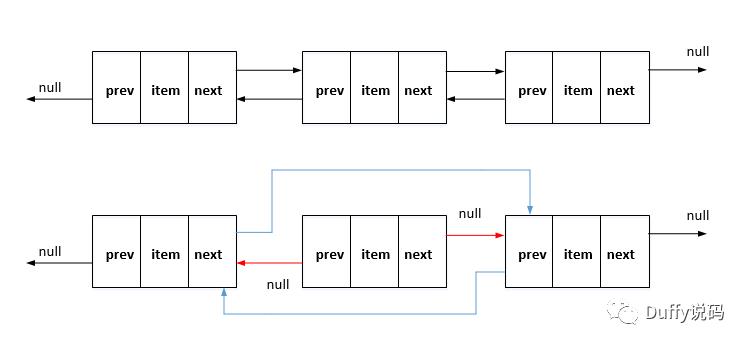
public void clear() {
for (Node<E> x = first; x != null; ) {
Node<E> next = x.next;
x.item = null;
x.next = null;
x.prev = null;
x = next;
}
first = last = null;
size = 0;
modCount++;
}
清除所有的元素,item、prev、next及first、last全部置为null,size置为0,改动次数增加1。清除节点之间的所有链接是“不必要的”,但是可帮助一代GC确保释放内存。
LinkedList遍历比较
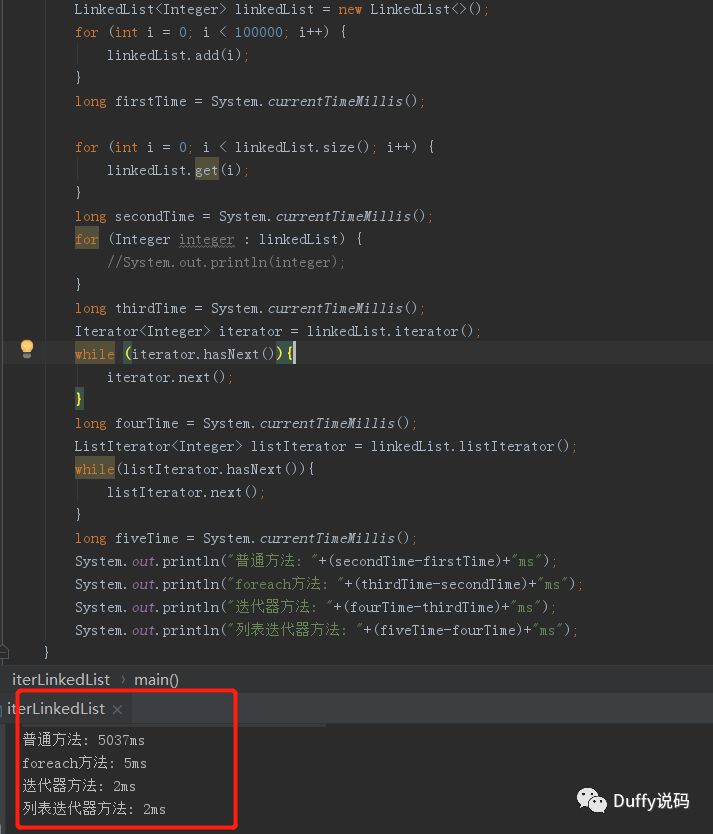
LinkedList遍历多次测试对比,表中单位为ms

通过跟踪源码,我们知道后三种方式都是通过以下执行的,所以时间花费相差不大
public ListIterator<E> listIterator() {
return listIterator(0);
}第一个问题LinkedList普通循环方法慢,而使用迭代器遍历更快?迭代器内部结构便知
private class ListItr implements ListIterator<E> {
private Node<E> lastReturned;
private Node<E> next;
private int nextIndex;
private int expectedModCount = modCount;
ListItr(int index) {
// assert isPositionIndex(index);
next = (index == size) ? null : node(index);
nextIndex = index;
}
public boolean hasNext() {
return nextIndex < size;
}
public E next() {
checkForComodification();
if (!hasNext())
throw new NoSuchElementException();
lastReturned = next;
next = next.next;
nextIndex++;
return lastReturned.item;
}
......
}
迭代器和普通循环方法对比起来少了一个list.get(i),LinkedList中调用了一次get(i),我们知道这个时间复杂度是O(n),再嵌套一个for循环是O(n^2);
迭代器其实每次没从first或last重新开始遍历,而是记录当前的位置,iterator中因为next的存在所以循环下来时间复杂度是O(n),因此差距就在这里。
第二个问题为什么ArrayList的普通循环比LinkedList要快?

ArrayList基于索引结构,实现RandomAccess接口,实现随机存取,元素是在堆空间连续存储的地址,查找元素不用遍历,所花费时间很少。而LinkedList中元素是在堆空间中没要求连续,通过prev、next指针相连的,只能通过遍历的方式存取,所以ArrayList的普通循环比LinkedList要快。
以上是关于Java基础干货LinkedList源码剖析的主要内容,如果未能解决你的问题,请参考以下文章
Java数据结构之链表的原理及LinkedList的部分源码剖析
Java基础干货Guava集合工具CollectionUtil源码剖析